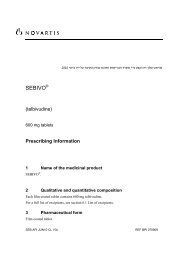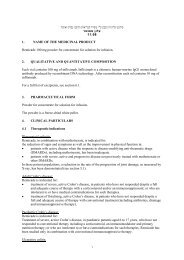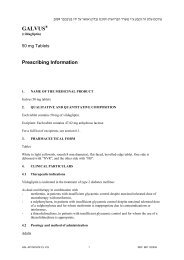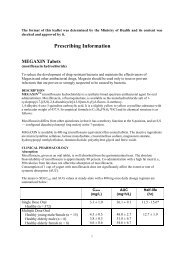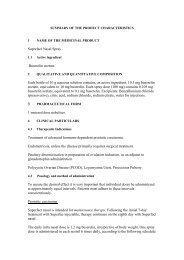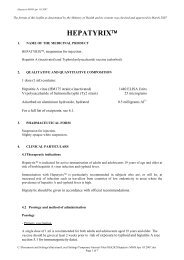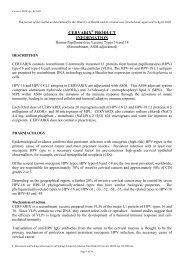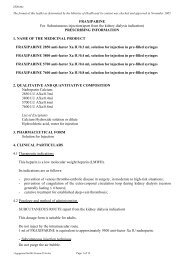SUMMARY OF PRODUCTS CHARACTERISTICS 1. NAME OF THE ...
SUMMARY OF PRODUCTS CHARACTERISTICS 1. NAME OF THE ...
SUMMARY OF PRODUCTS CHARACTERISTICS 1. NAME OF THE ...
You also want an ePaper? Increase the reach of your titles
YUMPU automatically turns print PDFs into web optimized ePapers that Google loves.
<strong>1.</strong> <strong>NAME</strong> <strong>OF</strong> <strong>THE</strong> MEDICINAL<br />
Neuleptil 4%, oral solution<br />
Neuleptil 10 mg, capsule<br />
<strong>SUMMARY</strong> <strong>OF</strong> <strong>PRODUCTS</strong> <strong>CHARACTERISTICS</strong><br />
2. QUALITATIVE AND QUANTITATIVE COMPOSTION<br />
3. PHARMACEUTICAL FORM<br />
4. CLINICAL PARTICULARS<br />
4.1 Therapeutic Indications<br />
Psychotic disorders<br />
4.2 Posology and method of administration<br />
1 drop contains 1 mg of periciazine<br />
1 ml of solution contains 40 drops<br />
ORAL ROUTE<br />
Always seek the minimum effective dose. If the clinical condition of the patient allows it,<br />
institute treatment at a low dose and gradually increase step-wise.<br />
The daily dose should be divided into two or three intakes.<br />
Adults :<br />
The dose is 30 to 100 mg/day.<br />
In certain exceptional cases, the dose may be increased to a maximum of 200 mg/day.<br />
4.3 Contra-indications<br />
This drug must not be used in the following cases :<br />
- hypersensitivity to periciazine or to one of the other ingredients of this medicinal<br />
product,<br />
- risk of angle-closure glaucoma,<br />
- risk of urinary retention linked to urethroprostatic disorders,<br />
- history of agranulocytosis,<br />
- combination with dopamine agonists (amantadine, apomorphine, bromocriptine,<br />
cabergoline, entacapone, lisuride, pergolide, piribedil, pramiprexole, quinagolide,<br />
ropinirole ) except in patients with Parkinson's disease<br />
תואירבה דרשמ י"<br />
ע עבקנ הז ןולע טמרופ<br />
2007 רבמבונב<br />
רשואו קדבנ ונכותו
AS GENERAL RULE, this drug SHOULD NOT BE USED in the following cases :<br />
- lactation ( see. Pregnancy and lactation)<br />
- combination with :<br />
. alcohol<br />
. levodopa<br />
- . dopamine agonists (amantadine, apomorphine, bromocriptine, cabergoline,<br />
entacapone, lisuride, pergolide, piribedil, pramiprexole, quinagolide, ropinirole ) in<br />
patients with Parkinson's disease<br />
- Breast cancer (potentially higher risk of disease progression and possible increased<br />
resistance to endocrine and cytotoxic treatment, due to phenothiazine-induced<br />
prolactin secretion<br />
4.4 Warnings and special precautions for use<br />
Warnings<br />
• All patients must be advised that if they experience fever, sore throat or any other<br />
infection, they should inform their physician immediately and undergo a complete<br />
blood count.<br />
Treatment will be discontinued if any marked changes (hyperleucocytosis,<br />
granulocytopenia) are observed in the latter.<br />
• Neuroleptic malignant syndrome : treatment must be interrupted in the event of<br />
unexplained hyperpyrexia since this can be one of the signs of neuroleptic malignant<br />
syndrome ( pallor, hyperthermia, disorders of autonomic function). Signs of<br />
autonomic instability, such as sweating and irregular blood pressure, can precede the<br />
onset of hyperthermia and as such constitue premonitory signs of this syndrome.<br />
While this neurolepic-related effect can be od idiosyncratic origin, certain risk factors<br />
such as dehydration and organic brain damage would seem to indicate a<br />
predisposition.<br />
• Prolonged QT interval : Neuroleptic phenothiazines may potentiate QT interval<br />
prolongation which increase the risk of onset of serious ventricular arrhythmias of the<br />
torsade de pointes type which is potentially fatal (sudden death). Periciazine prolongs<br />
the QT interval in a dose-dependent fashion.<br />
This effect, which is known to increase the risk of developing serious ventricular<br />
arrhythmias of the torsades de pointes type, is exacerbated in the presence of<br />
bradycardia, hypokalemia, and congenital or acquired long QT syndrome<br />
(concomitant administration with a QT interval prolonging drug). Where clinically<br />
possible, the absence of any factors favouring the onset of ventricular arrhythmias<br />
should be ensured before administration :<br />
- Bradycardia less than 55 beats per minute,<br />
- Hypokalemia<br />
- Congenital QT interval prolongation.<br />
- Ongoing treatment with any drug that could induce marked bradycardia (
• With the exception of emergencies, it is recommended that the intitial work up of<br />
patients receiving a neuroleptic should include an ECG.<br />
• Except under exceptional circumstances, this drug must not be administered to<br />
patients with Parkinson’s disease and in patients suffering from severe CNS<br />
depression<br />
• The onset of paralytic ileus with abdominal bloating and pain, must be treated as an<br />
emergency.<br />
• The solution contains sucrose and are therefore contraindicated in patients with<br />
fructose intolerance, congenital galactosemia, glucose or galactose malabsorption<br />
syndrome, and sucrase-isomalte deficiency<br />
Special precautions for use<br />
The following populations must be closely monitored afer administration of periciazine :<br />
• epileptic patients, since periciazine may lower the seizure threshold. Treatment must<br />
be discontinued if seizures occur,<br />
• elderly patients presenting with :<br />
- heightened susceptibility to postural hypotension, sedation and extrapyramidal effects,<br />
- chronic constipation (risk of paralytic ileus),<br />
- and potentially prostatic hypertrophy,<br />
• patients presenting with certain forms of cardiovascular disease since this class of drug<br />
has quinidine-like effects and can induce tachycardia and hypotension,<br />
• patients with severe liver and/or renal failure because of the risk of accumulation.<br />
•<br />
Respiratory disorders, chronic, especially in children (may be potentiated due to CNS<br />
depressant effect of phenothiazines . also, cough-suppressant effects of phenothiazines may be<br />
especially problematic in these patients<br />
Patients are strongly advised not to consume alcohol and alcohol-containing drugs throughout<br />
treatment.<br />
The alcohol content of the solution is 9 %, that is to say 90 mg of alcohol for 40 drops. His<br />
presentation is inadvisable for patients suffering of liver disease, alcoholism, epilepsy,<br />
medical and traumatic cerebral disorders.<br />
Caution should also be used in geriatric, emaciated, and debilitated patients, who usually<br />
require a lower initial dose . , and in patients who will be exposed to organophosphate or<br />
carbamate pesticides , extreme heat , or extreme cold<br />
When extended therapy is discontinued, a gradual reduction in phenothiazine dosage over<br />
several weeks is recommended, since abrupt withdrawal may cause some patients on high or<br />
long-term dosage to experience transient dyskinetic signs, nausea, vomiting, gastritis,<br />
trembling, and/or dizziness .. The continuation of treatment with antidyskinetic medications<br />
for several weeks after discontinuing the phenothiazine may reduce these symptoms . but can<br />
precipitate psychosis .. Also, preliminary evidence suggests that gradual dosage reduction<br />
may decrease the relapse risk associated with discontinuation .
Stroke:<br />
In randomised clinical trials versus placebo performed in a population<br />
of elderly patients with dementia and treated with certain atypical<br />
antipsychotic drugs, a 3-fold increase of the risk of cerebrovascular events has<br />
been observed. The mechanism of such risk increase is not known. An<br />
increase in the risk with other antipsychotic drugs or other populations of<br />
patients cannot be excluded. Nozinan should be used with caution in<br />
patients with stroke risk factors.<br />
4.5 Interaction with other medicinal products and other forms of interaction<br />
Contraindicated association<br />
Dopamine agonists (amantadine, apomorphine, bromocriptine, cabergoline, entacapone,<br />
lisuride, pergolide, piribedil, pramiprexole, quinagolide, ropinirole) except in patients with<br />
Parkinson's disease<br />
Reciprocal antagonism of the dopamine agonist and neuroleptic drugs.<br />
Neuroleptic-induced extrapyramidal syndrome should be treated with an anticholinergic<br />
rather than a dopamine agonist.<br />
Inadvisable associations<br />
+ Alcohol :<br />
Alcohol potentiates the sedative effects of neuroleptics. Impaired vigilance may make it<br />
hazardous to drive motor vehicles or operate machinery.<br />
Avoid consumption of alcoholic beverages and medications containing alcohol.<br />
+ Levopoda :<br />
Reciprocal interaction between levodopa and neuroleptic drugs.<br />
In patients with Parkinson's disease, minimum effective doses of each medication should be<br />
used.<br />
+ Dopamine agonists (amantadine, apomorphine, bromocriptine, cabergoline, entacapone,<br />
lisuride, pergolide, piribedil, pramiprexole, quinagolide, ropinirole) in patients with<br />
Parkinson's disease<br />
Reciprocal interaction between dopamine agonists and neuroleptic drugs. Dopamine agonists<br />
may induce or aggravate psychotic disorders. If a Parkinsonian patient taking dopamine<br />
agonists requires neuroleptic treatment, dopamine agonists should be gradually decreased<br />
until discontinuation (sudden discontinuation of dopamine exposes the patient to risk of<br />
«neuroleptic malignant syndrome»).<br />
Associations requiring precautions for use<br />
+ Topical gastrointestinal agents (magnesium, aluminium and calcium salts, oxides and<br />
hydroxides) : decreased GI absorption of phenothiazine neuroleptics. Do not administer<br />
phenothiazine neuroleptics simultaneously with topical GI agents (administer more than 2<br />
hours apart if possible).
Associations to be taken into account<br />
+ Antihypertensive agents : potentiation of the antihypertensive effect and risk of postural<br />
hypotension (additive effects). (See below for guanethidine).<br />
+ Guanethidine : inhibition of the antihypertensive effects of guanethidine (inhibition of<br />
guanethidine uptake into sympathetic fibre, its site of action).<br />
+ Atropine and other atropine derivatives : imipramine antidepressants, histamine H1receptor<br />
antagonists, anticholinergic antiparkinsonism agents, atropinic antispasmodics,<br />
disopyramide : build up of atropine-associated adverse effects such as urinary retention,<br />
constipation and dry mouth, etc.<br />
+ Other CNS depressants : morphine derivatives (analgesics, antitussives and substitution<br />
treatments), barbiturates, benzodiazepines, anxiolytics other than benzodiapezines, carbamate,<br />
captodiame, etifoxine, hypnotics, sedative antidepressants, histamine H1 receptor antagonists,<br />
central antihypertensive agents, baclofen, thalidomide : increased central depression. Changes<br />
in alertness can make it dangerous to drive motor vehicles or operate machinery.<br />
4.6 Pregancy and lactation<br />
Pregnancy<br />
Animal studies have not evidenced teratogenicity.<br />
In humans, the teratogenic risk of periciazine has not been evaluated. Different prospective<br />
epidemiological studies conducted with other phenothiazines have yielded contradictory<br />
results regarding teratogenic risk. No data exists regarding the impact of neuroleptics on the<br />
foetal brain when administered throughout pregnancy.<br />
Rare instances of the following have been observed in the neonates of mothers receiving long<br />
term treatment with high doses of neuroleptics :<br />
- signs related to the atropinic properties of phenothiazines (abdominal bloating,<br />
meconium ileus, delayed meconium passage, initial feeding difficulties, tachycardia,<br />
neurological disorders, etc.),<br />
- extrapyramidal syndromes.<br />
Consequently, the teratogenic risk, if it exists, appears to be low. Attempting to limit<br />
treatment duration during pregnancy appears reasonable.<br />
If possible, the dosages of both neuroleptic drugs and corrective antiparkinsonism agents<br />
potentiating the atropinic effects of neuroleptics should be reduced near term. A period of<br />
monitoring the neurological and gastrointestinal functions of the neonate appears warranted.<br />
Lactation<br />
In absence of data on excretion of the drug in breast milk, breast-feeding is not recommended<br />
during treatment.
4.7 Effects on ability to drive and use machines<br />
The attention of patients, particularly drivers and machine operators, should be drawn to the<br />
risk of drowsiness with this medication especially at the start of treatment.<br />
4.8 Undesirable effects<br />
At low doses :<br />
-Autonomic reactions :<br />
. Postural hypotension.<br />
. Anticholinergic effects such as dry mouth, accommodation disorders, risk of urinary<br />
retention, constipation and even paralytic ileus (see Special warnings and special precautions<br />
for use).<br />
- Neuropsychaitric disorders :<br />
. Sedation or drowsiness, particularly at the start of treatment.<br />
. Lethargy, anxiety, mood disorders.<br />
At higher doses :<br />
. Early manifestations of dyskinesia (spasmodic torticolis, oculogyric crises, trismus, etc.).<br />
. Tardive dyskinesia, particularly during long-term treatment.<br />
Anticholinergic antiparkinsonism agents have no effect or aggravate the symptoms.<br />
. Extrapyramidal syndrome :<br />
- akinetic with or without hyertonia, partially resolving with anticholinergic<br />
antiparkinsonism agents,<br />
- hyperkinetohypertonic, excitomotor,<br />
- akathisia<br />
- Endocrine and metabolic reactions :<br />
. Hyperprolactinemia : amenorrhoea, galactorrhoea, gynecomastia, impotence, frigidity.<br />
. Weight gain.<br />
. Thermoregulation disorders<br />
. Hyperglycemia, changes in glucose tolerance.<br />
Rarely, and in a dose dependent manner :<br />
- Cardiac disorders :<br />
. QT interval prolongation.<br />
Very rarely and independent of dose :<br />
- Skin reactions :<br />
. Allergic skin reactions.<br />
. Photosensitivity.<br />
- Haematological disorders :<br />
. Exceptionally agranulocytosis : regular blood counts are recommended.<br />
. Leucocytopenia
- Ophthalmologic disorders :<br />
.Brownish deposits in the anterior segment of the eye caused by accumulation of the<br />
drug but generally without any impact on sight.<br />
- Miscellaneous :<br />
. Positive antinuclear antibodies wihtout clinical lupus erythematosus.<br />
. Possible cholestatic jaundice.<br />
. Neuroleptic malignant syndrome (see Warnings).<br />
Cholestatic jaundice and liver injury, mainly of cholestatic or mixed type, are very rarely<br />
reported in patients treated with periciazine. Priapism has been very rarely reported in patients<br />
treated with periciazine.<br />
There have been isolated reports of sudden death, with possible causes of cardiac origin ( see<br />
Warnings ), as well as cases of unexplained sudden death, in patients receiving neuroleptic<br />
phenothiazines.<br />
4.9 Overdose<br />
Extremely severe drug-induced parkinsonism, coma.<br />
Symptomatic treatment, continuous respiratory and cardiac monitoring (risk of prolonged QT<br />
interval) until the patient’s condition resolves.<br />
5. PHARMACOLOGICAL PROPERTIES<br />
5.1 Pharmacodynamic properties<br />
ANTIPSYCHOTIC – NEUROLEPTIC<br />
PHENOTHIAZINE WITH PIPERIDINE STRUCTURE<br />
(N: central nervous sysytem)<br />
Neuroleptic antipsychotics have antidopaminergic properties to which are imputed :<br />
• the antipsychotic effect sought in therapy,<br />
• adverse effects (extrapyramidal syndrome, dyskinesias, hyperprolactinemia).<br />
Periciazine has moderate antidopaminergic activity, its antipsychotic activity is moderated, it<br />
has moderate extrapyramidal effects.<br />
The molecule also has antihistamine properties ( causing sedation, a generally desired effect<br />
In the clinic). It has marked adrenolytic and anticholinergic properties.<br />
Neuleptil caps - Manufacturer: Haupt Pharma Livron, France<br />
Neuleptil drops - Manufacturer: Aventis Pharma Ireland<br />
License Holder : Sanofi-Aventis Israel ltd.



